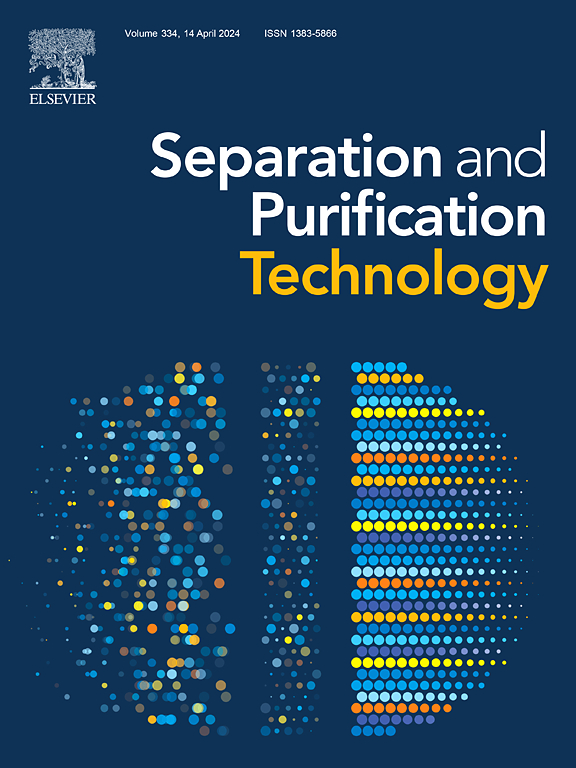碳纳米纤维负载锰活化过氧单碳酸酯对诺氟沙星的高效降解
IF 8.1
1区 工程技术
Q1 ENGINEERING, CHEMICAL
引用次数: 0
摘要
由于过氧单碳酸酯(PMC)活化体系的有效性、环保性和成本效益,对其去除抗生素的能力进行了研究。本文采用电纺丝-稳定-碳化的方法合成了锰负载的纳米碳纤维(Mn/CNFs),以激活PMC高效降解诺氟沙星(NOR)。纳米氧化锰分布在纳米碳纤维中,有效地阻止了金属的浸出。在PMC活化体系中,金属/CNFs对NOR的催化活性依次为:Mn/CNFs >; Cu/CNFs >; Co/CNFs >; W/CNFs >; V/CNFs,这可能为PMC活化提供重要信息。此外,锰比其他金属更环保,储量也更丰富。Mn/CNFs对PMC的催化活性高于其他过氧化物(如过氧单硫酸盐、H2O2和过硫酸盐)。Mn/ cnf活化的PMC系统在60 min内对NOR的降解效率为90.6 %,第三次循环后该效率仅下降3.8 %,表明Mn/ cnf具有良好的可回收性。活性氧(1O2、CO3·−、O2·−和·OH)主要负责NOR的去除,其中1O2起主导作用。共鉴定出14个中间体,提出了哌嗪开环、喹诺酮开环、脱羧和去乙基三种NOR的降解途径。此外,根据生态构效关系模型,92.8 %的NOR降解中间体是无害的。该研究为设计高效的金属催化剂活化PMC提供了重要信息。本文章由计算机程序翻译,如有差异,请以英文原文为准。


Peroxymonocarbonate activation via carbon nanofibers supported manganese for efficient norfloxacin degradation
Peroxymonocarbonate (PMC) activation system has been investigated for its ability to remove antibiotics due to its effectiveness, environmental friendliness and cost-effectiveness. Herein, carbon nanofibers supported with manganese (Mn/CNFs) were synthesized by an electrospinning-stabilization-carbonization method to activate PMC for efficient norfloxacin (NOR) degradation. The manganese oxide nanoparticles were distributed in the carbon nanofibers, which effectively prevented the metal leaching. The catalytic activity of the metal/CNFs for NOR removal in the PMC activation system followed: Mn/CNFs > Cu/CNFs > Co/CNFs > W/CNFs > V/CNFs, which might provide important information for PMC activation. In addition, Mn is more environmentally friendly and abundant than other metals. The Mn/CNFs exhibited higher catalytic activity for PMC activation than other peroxides (e.g., peroxymonosulfate, H2O2 and persulfate). The NOR degradation efficiency was 90.6 % in the Mn/CNF-activated PMC system within 60 min, and this efficiency only decreased by 3.8 % after the third cycle, indicating the good recyclability of the Mn/CNFs. The reactive species (1O2, CO3·−, O2·− and ·OH) were responsible for NOR removal, and 1O2 played the dominant role. Fourteen intermediates were identified, and three degradation pathways of NOR were proposed, including piperazine ring opening, the quinolone ring opening, decarboxylation and deethyl groups. Furthermore, 92.8 % of the NOR degradation intermediates were nonharmful according to the ecological structure–activity relationship model. This study provides important information to design efficient metal catalysts for PMC activation.
求助全文
通过发布文献求助,成功后即可免费获取论文全文。
去求助
来源期刊

Separation and Purification Technology
工程技术-工程:化工
CiteScore
14.00
自引率
12.80%
发文量
2347
审稿时长
43 days
期刊介绍:
Separation and Purification Technology is a premier journal committed to sharing innovative methods for separation and purification in chemical and environmental engineering, encompassing both homogeneous solutions and heterogeneous mixtures. Our scope includes the separation and/or purification of liquids, vapors, and gases, as well as carbon capture and separation techniques. However, it's important to note that methods solely intended for analytical purposes are not within the scope of the journal. Additionally, disciplines such as soil science, polymer science, and metallurgy fall outside the purview of Separation and Purification Technology. Join us in advancing the field of separation and purification methods for sustainable solutions in chemical and environmental engineering.
 求助内容:
求助内容: 应助结果提醒方式:
应助结果提醒方式:


